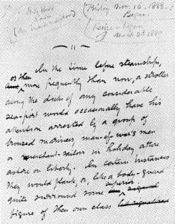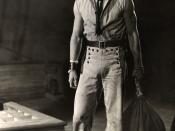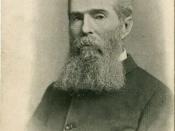1. Using Billy Budd as an example, define the following literary terms: point of view, irony, paradox, dilemma, symbol, tragic flaw, and theme.
-Point of view- The point of view is that of omniscient narration.
-Irony-
Irony is defined as "the use of words to convey the opposite of their literal meaning". In the beginning of the story Billy is described as an innocent, likeable, and sweet man. Towards the end of the story he is described as a murderer. This is ironic because his deathly action was unanticipated by the reader. The irony continues throughout the story as Billy Budd dies. There stands a monument at the place Billy was hanged. Billy dies in defeat, but he comes back as a living symbol.
-Paradox-
Paradox is defined as "a statement actually self-contradictory or false." Captain Vere stands for what is right and orderly. It is right for God to spare the innocent, but wrong for Captain Vere not to execute Billy.
The chaplain is getting paid by the War Department.
-Dilemma-
Captain Vere is faced with dilemma when Billy accidentally kills Claggart. He is faced with a question, whether to trust his head or his heart.
-Symbol-
This story shows biblical symbolism. Billy portrays a Christ-like character before his fall. His white clothing symbolizes innocence. Claggart manipulated Billy like the serpent manipulated Adam. Claggart and Billy's death is symbolic because the deaths contrast each other.
-Tragic Flaw-
Billy's only flaw was that he couldn't handle emotional situations.
-Theme-
The theme is as simple as good vs. evil. Evil won in the short-term, and good won in the long-term. In the story good and evil is compared to war. It's an eternal conflict.
2. Describe Billy Budd as a character and tell what he symbolizes.
Billy Budd has...


